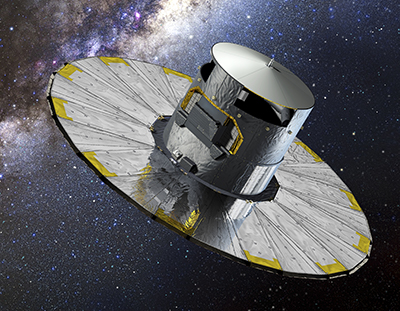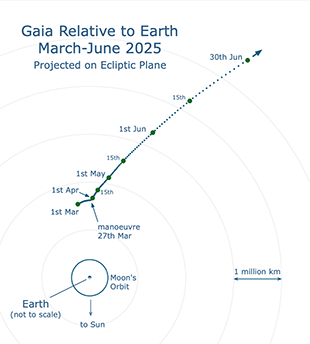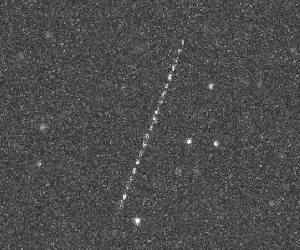
Artist's impression of Gaia. Image ©2013 ESA/D.Ducros
March 27th saw the European Space Agency (ESA) switch off the Gaia spacecraft, ending one chapter of a mission that continues to revolutionise our understanding of the Milky Way galaxy we live in.
Launched in 2013, Gaia was put into a Lissajous orbit around the Sun-Earth L2 Lagrange point, 1.5 million km from Earth. There it precisely mapped the positions, distances, velocities, and properties of nearly two billion stars and other celestial objects in our galaxy. It has provided us with the largest, most precise multi-dimensional map of our galaxy ever created, revealing the Milky Way's structure and evolution in unprecedented detail.
Gaia uncovered evidence of past galactic mergers, identified new star clusters, contributed to the discovery of exoplanets and black holes, mapped millions of quasars and galaxies, and tracked hundreds of thousands of asteroids and comets. It also enabled the creation of the best visualisation of how our galaxy might look to an outside observer.
These discoveries came in part due to Gaia's incredible precision. It measured stellar positions to the nearest five-hundred-millionth of a degree — like using a telescope in London to measure the width of a human hair in Rome.
The LT's role in the Gaia mission
This unprecedented level of precision depended in part on accurate tracking of Gaia itself. Its position needed to be known to the nearest 150 metres, and its velocity to 2.5 mm/s. ESA used a special radar technique for this, but could only use it on Gaia 1-2 times a month, so ESA turned to ground-based optical telescopes to fill the gaps in coverage. The Gaia Ground-Based Optical Tracking (GBOT) campaign utilised the VLT Survey Telescope (VST) at Paranal in Chile, and the Liverpool Telescope. The two Faulkes Telescopes in Hawaii and Australia provided backup whenever both VST and LT were offline at the same time.
The LT is fully robotic. With no human intervention it decides for itself what to observe, drawing from a database of submitted requests from astronomers around the world. These requests can be dropped into the database at any time, so astronomers can spread out their allocated time throughout the semester any way they like. This unique flexibility for a professional telescope of this size made it perfect for tracking Gaia.
The LT took 20-40 exposures of Gaia for GBOT on every moonless night, using its workhorse imaging camera IO:O. The data was automatically processed the next morning and made available to GBOT staff at the Observatoire de Paris in France. Their pipeline automatically detected Gaia in the images, using a technique based on an idea provided by LT staff. Gaia's position was routinely measured to the 150 metre precision required for the mission — like measuring to the nearest millimetre from 10 kilometres away.

Gaia's trajectory relative to Earth from 1st March through June 2025. Part of original L2 orbit visible 1-27 March, followed by acceleration away from Earth after orbital manoeuvre. ©2025 J.Marchant using data from JPL Horizons System.
This coordinate data, plus that provided by the VST and Faulkes, allowed ESA's European Space Operations Centre (ESOC) in Darmstadt, Germany to calculate Gaia’s exact position and velocity in space. This ultimately helped to refine the Gaia catalogue’s amazing precision.
So far, three major catalogues or "Data Releases" have been made public. DR1 (Data Release 1) came out in 2016, DR2 in 2108, and DR3 in 2022, but more are to come — the Gaia spacecraft may be switched off but the Gaia mission is far from over. The huge amount of data generated is still being analysed and more discoveries are being made. The next Data Release, DR4, is scheduled for mid-2026. The final release, DR5, is expected in or around 2030.
Gaia itself is now drifting slowly and silently away from Earth space (see left). Before being switched off it was boosted out of halo orbit and is now moving around the Sun in an orbit a little larger and slower than the Earth's. Every ~14 years it will make a full circle relative to Earth and swing past our planet. By design, closest approach will be no closer than 10 million kilometres so that Gaia doesn't interfere with future space missions.



